-
string容器的常用操作
string容器的常用操作
一、C语言中的字符串
在C语言中,字符串是以\0结尾的一串字符的集合,而为了操作方便,C标准库中提供了一些str系列的库函数,比如,strcpy、strlen、strcmp等等。但是这些库函数与字符串是分离开的,不太符合OOP的思想(面向对象编程(Object Oriented Programming)),而且底层空间需要用户自己管理,稍不留神可能就会有越界访问的问题发生。
二、string容器
1、概念
string容器是c++中表示字符序列的一个类,同时也是一个类模板。它提供了许多成员函数和运算符重载,封装了C++中对字符串的常见操作和功能,提供了更高级的字符串处理能力,并且隐藏了底层的实现细节,使得字符串的操作更加方便和安全。但string类是一个泛型类,它是由模板实例化出来的一个标准类,本质上不是一个标准数据类型。详情参见上方string容器文档。
2、特点
- 标准的字符串类提供了对此类对象的支持,其接口类似于标准字符容器的接口,但添加了专门用于操作单字节字符和字符串的设计特性。
- string类是basic_string模板类的一个实例,它使用char作为basic_string模板类的类型去实例化,并用char_traits和allocator作为basic_string的默认参数(模板的概念参见模板和STL简介)。
- string类处理字节与使用的编码无关。即如果用于处理多字节或可变长度字符(如 UTF-8)的序列,则此类的所有成员(如长度或大小)及其迭代器仍将以字节(而不是实际编码字符)为单位运行。
- 在使用string类时,必须用#include包含它的头文件string以及使用标准命名空间std。
三、string类对象的常见构造
1、构造
常用构造函数名称 功能说明 string() 创建一个空的string类对象,即空字符串 string(const char* s) 用C语言格式的字符串来构造string类对象 string(size_t n, char c) 创建一个包含n个字符c的string类对象 string(const string& str) string类的拷贝构造函数,用对象str创建一个string类对象 2、实际构造函数

3、测试代码
#include#include using namespace std; void Test_string1() { string s1; cout << s1 << endl; string s2("snow dragon"); cout << s2 << endl; string s3(6, 's'); cout << s3 << endl; string s4(s2); cout << s4 << endl; } int main() { try { Test_string1(); } catch (const std::exception& e) { cout << e.what() << endl; } return 0; } - 1
- 2
- 3
- 4
- 5
- 6
- 7
- 8
- 9
- 10
- 11
- 12
- 13
- 14
- 15
- 16
- 17
- 18
- 19
- 20
- 21
- 22
- 23
- 24
- 25
- 26
- 27
- 28
- 29
- 30
- 31
- 32
- main函数中的try与catch的作用是捕获异常。
4、运行结果

四、赋值运算符
1、类型

2、作用
=运算符用一个新值为string对象的字符串赋值,它会替换掉string对象字符串之前的内容。
3、测试代码
int main() { string s1; string s2 = "snow dragon"; // 调用构造函数 + 拷贝构造 -> 编译器优化 --> 直接调用构造函数创建对象s2 cout << s1 << endl; cout << s2 << endl; s1 = s2; cout << s1 << endl; s1 = "ssss"; cout << s1 << endl; s1 = 's'; cout << s1 << endl; return 0; }- 1
- 2
- 3
- 4
- 5
- 6
- 7
- 8
- 9
- 10
- 11
- 12
- 13
- 14
- 15
- 16
- 17
- 18
- 19
4、运行结果

五、string类对象的容量操作
1、成员函数
函数名称 功能说明 size_t size() const; 返回字符串的长度(以字节为单位)。 size_t capacity() const; 返回当前为字符串分配的存储空间的大小,以字节表示。 bool empty() const; 返回字符串是否为空,即其长度是否为 0。 void clear(); 擦除字符串的内容,该字符串将成为空字符串(长度为 0 个字符)。 void reserve (size_t n = 0); 请求更改容量的大小,对字符串(对象)长度没有影响,并且无法更改其内容。 void resize (size_t n);void resize (size_t n, char c); 将字符串的大小调整为n个字符的长度,即修改size。 2、测试代码
void Test_string2() { string s1("snow"); cout << s1 << endl; cout << s1.size() << endl; cout << s1.capacity() << endl; cout << s1.empty() << endl; cout << "***************************" << endl; string s2; cout << s2.empty() << endl; cout << "***************************" << endl; string s3("snow"); cout << s3 << endl; cout << s3.size() << endl; s3.resize(10, '!'); cout << s3 << endl; cout << s3.size() << endl; s3.resize(3); cout << s3 << endl; cout << s3.size() << endl; cout << "***************************" << endl; string s4; s4.reserve(100); cout << s4.size() << endl; cout << s4.capacity() << endl; s4.reserve(50); cout << s4.size() << endl; cout << s4.capacity() << endl; cout << "***************************" << endl; s1.clear(); cout << s1 << endl; cout << s1.size() << endl; cout << s1.capacity() << endl; }- 1
- 2
- 3
- 4
- 5
- 6
- 7
- 8
- 9
- 10
- 11
- 12
- 13
- 14
- 15
- 16
- 17
- 18
- 19
- 20
- 21
- 22
- 23
- 24
- 25
- 26
- 27
- 28
- 29
- 30
- 31
- 32
- 33
- 34
- 35
- 36
- 37
- 38
- 39
- 40
- 41
- 42
- 43
3、说明
- string类对象的容量操作函数中其实还有函数size_t length() const。只不过它不常用,并且size()与length()函数的底层实现原理完全相同,这里引入size()的原因是为了与其他容器的接口保持一致,一般情况下基本都是使用函数size()。
- 函数clear()只是将string中有效字符清空,即将string对象中的字符串清空时,只是将size置为0,但不改变对象的底层空间大小。
- resize(size_t n) 与 resize(size_t n, char c)都是将字符串中有效字符个数改变到n个,不同的是当字符个数增多时:resize(n)是用0来对多出的空间的元素进行赋值,resize(size_t n, char c)是用字符c来对多出的空间的元素进行赋值。
- resize在改变元素个数时,如果是将元素个数增多,可能会改变容量空间的大小,如果是将元素个数减少,则它的容量空间不会改变。
- reserve(size_t res_arg=0);的作用是为string对象预留空间,它不改变有效元素个数,即对容量空间大小进行处理。但当reserve的参数小于string的容量空间总大小时,reserver不会改变容量空间的大小。
4、运行结果
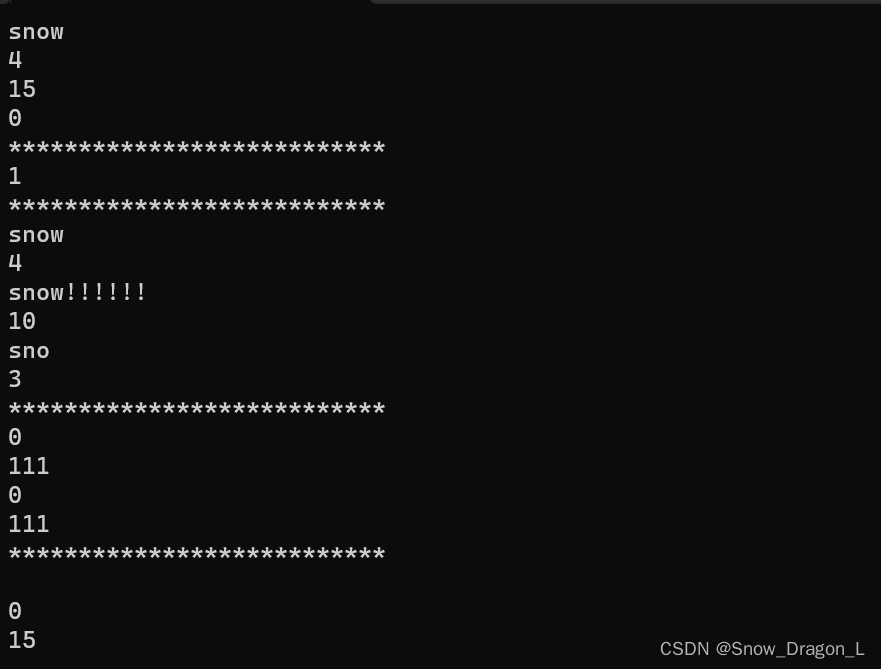
六、运算符[]
1、类型

2、作用
返回string对象字符串下标为pos的字符的引用。
3、测试代码
void Test2() { string s1("snow dragon"); cout << s1[0] << endl; cout << s1 << endl; s1[0] = 'h'; cout << s1[0] << endl; cout << s1 << endl; //遍历string对象并对它的每个字符+1 for (size_t i = 0; i < s1.size(); ++i) { s1[i]++; } cout << s1 << endl; const string s2("dragon"); for (size_t i = 0; i < s2.size(); ++i) { //s2[i]++; cout << s2[i] << " "; } cout << endl; cout << s2 << endl; //cout << s2[10] << endl; //编译器内部会检查是否越界 }- 1
- 2
- 3
- 4
- 5
- 6
- 7
- 8
- 9
- 10
- 11
- 12
- 13
- 14
- 15
- 16
- 17
- 18
- 19
- 20
- 21
- 22
- 23
- 24
- 25
- 26
- 27
- 28
4、运行结果
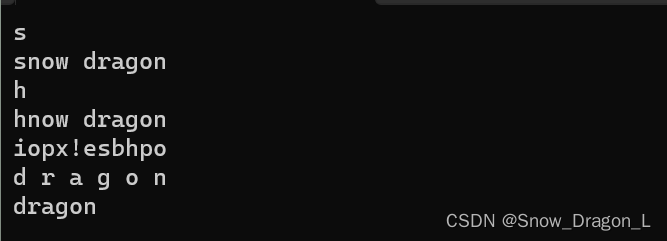
5、错误代码与编译器报错
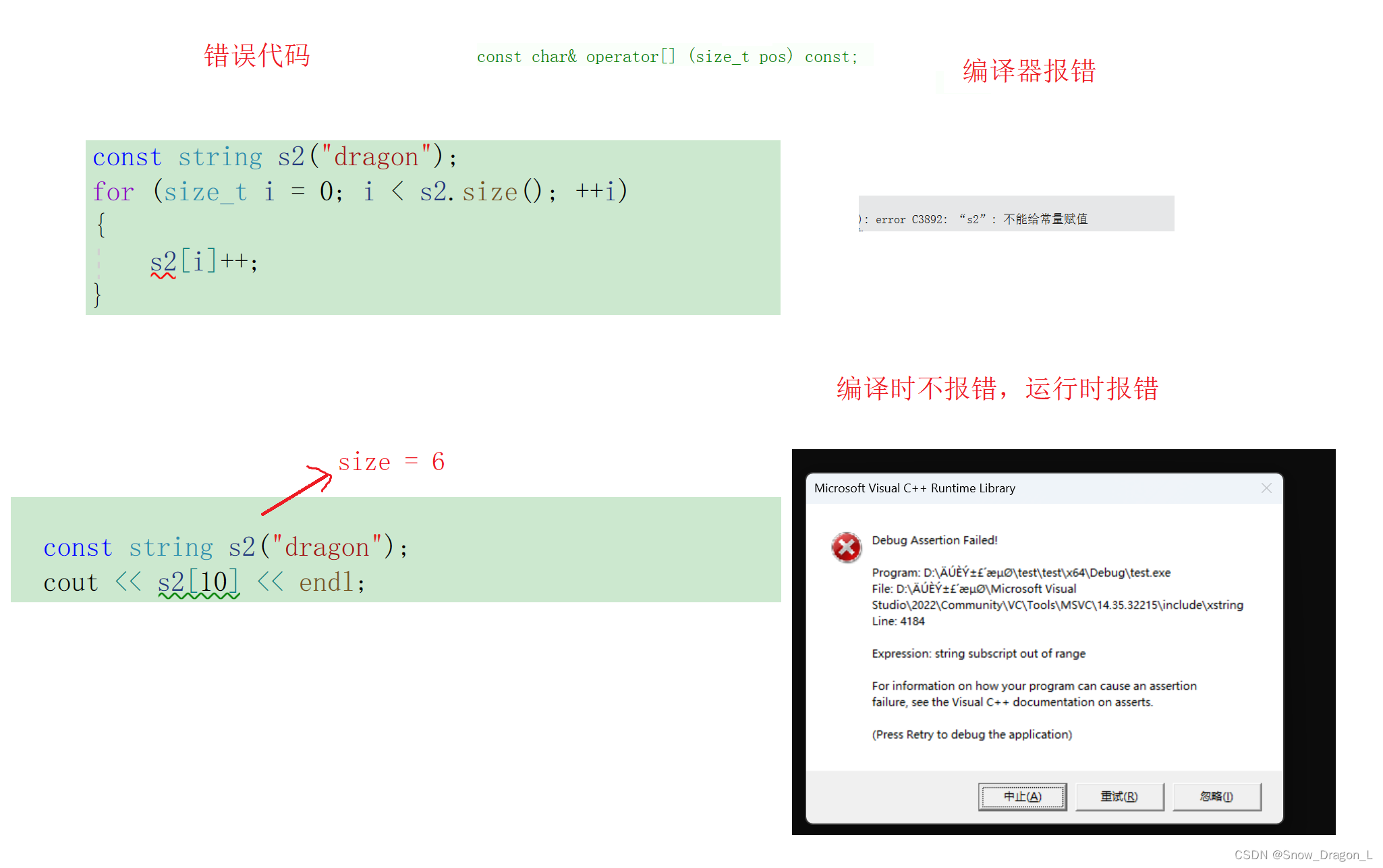
七、迭代器
1、类型
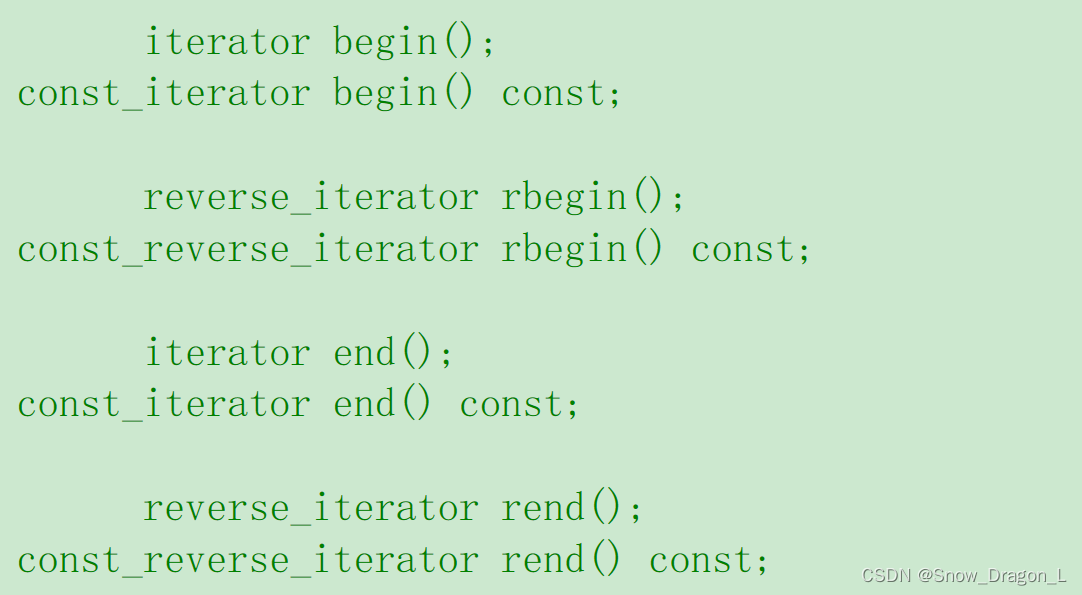
2、概念
迭代器是一种检查容器内的元素并遍历元素的数据类型,通常用于对C++中各种容器内的元素进行访问。
3、测试代码
void Test3() { cout << "s1 test" << endl; string s1("snow"); cout << s1 << endl; string::iterator it1 = s1.begin(); while (it1 != s1.end()) { (*it1)++; cout << *it1 << " "; ++it1; } cout << endl; //范围for: 自动迭代,自动判断结束。底层其实就是迭代器 //下方为使用范围for依次取s1中的每个字符并赋值给ch,再将ch自增1,最后输出 for (auto& ch : s1) { ch++; cout << ch << " "; } cout << endl; cout << s1 << endl; cout << "s2 test" << endl; string s2("snow dragon"); cout << s2 << endl; string::reverse_iterator rit2 = s2.rbegin(); while (rit2 != s2.rend()) { cout << *rit2 << " "; ++rit2; } cout << endl; cout << "s3 test" << endl; const string& s3("snow dragon"); cout << s3 << endl; //string::const_iterator it3 = s3.begin(); auto it3 = s3.begin(); while (it3 != s3.end()) { //*it3 = 'x'; cout << *it3 << " "; ++it3; } cout << endl; cout << "s3 reverse iterator test" << endl; //auto rit3 = s3.rbegin(); string::const_reverse_iterator rit3 = s3.rbegin(); while (rit3 != s3.rend()) { cout << *rit3 << " "; ++rit3; } cout << endl; }- 1
- 2
- 3
- 4
- 5
- 6
- 7
- 8
- 9
- 10
- 11
- 12
- 13
- 14
- 15
- 16
- 17
- 18
- 19
- 20
- 21
- 22
- 23
- 24
- 25
- 26
- 27
- 28
- 29
- 30
- 31
- 32
- 33
- 34
- 35
- 36
- 37
- 38
- 39
- 40
- 41
- 42
- 43
- 44
- 45
- 46
- 47
- 48
- 49
- 50
- 51
- 52
- 53
- 54
- 55
- 56
- 57
- 58
- 59
- 60
- 61
- 62
- 63
- 64
- 65
4、运行结果
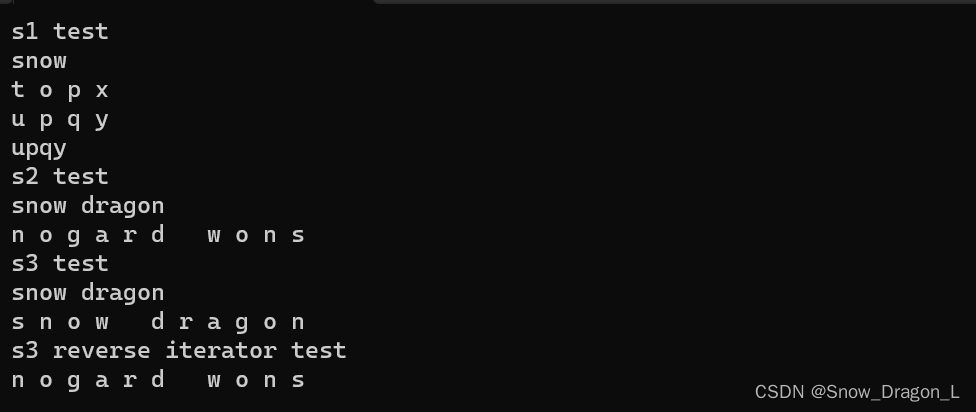
5、总结
- string和vector都不喜欢用iterator,因为[]更好用,而list、map和set等等只能用迭代器进行访问。
- iterator是所有容器通用的访问方式,即所有容器的用法都是类似的。
- iterator的用法像指针一样,它的底层实现有可能就是用指针实现的,也有可能不是,具体要看容器本身。
八、增加字符的函数
1、类型
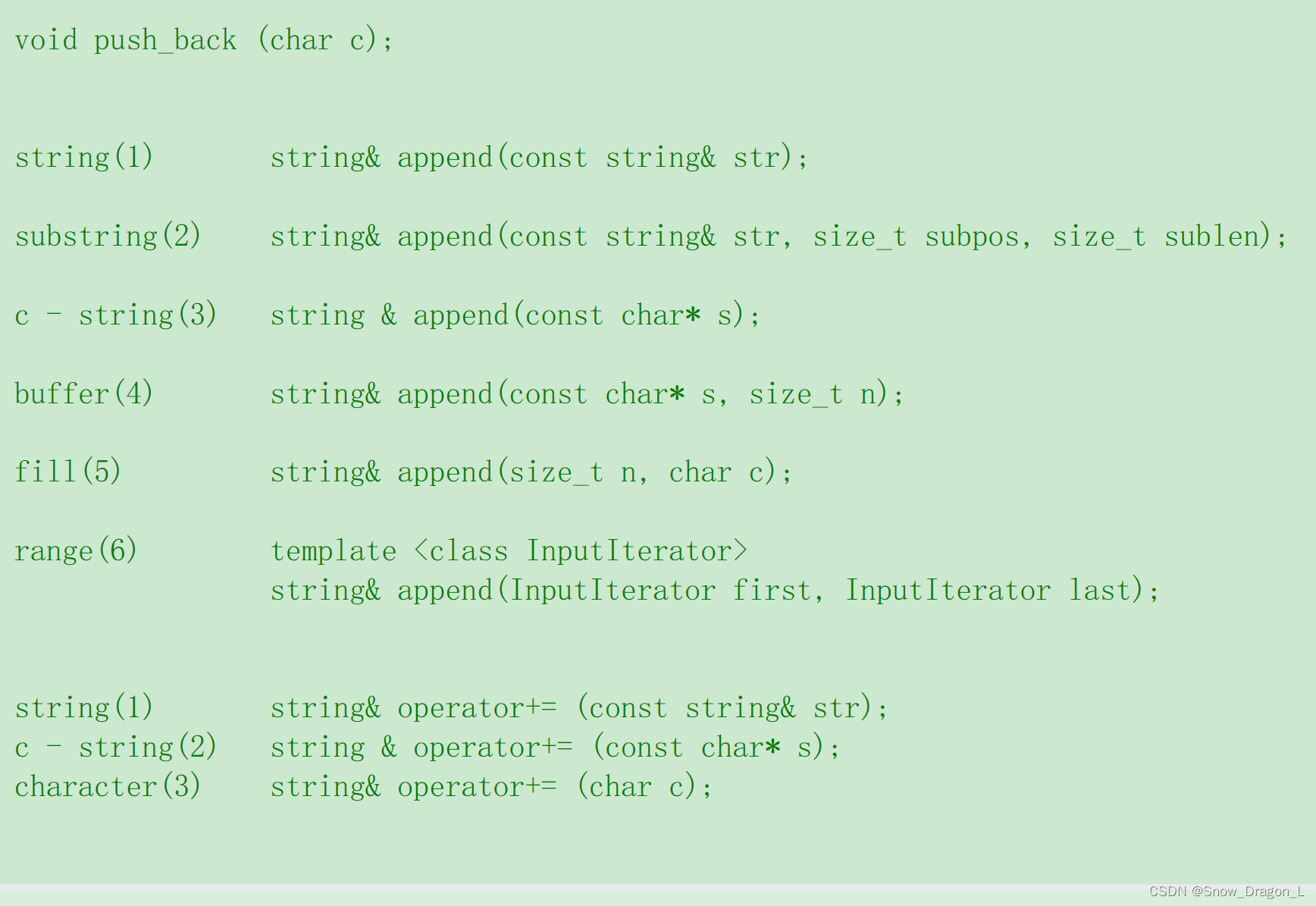
2、作用
- push_back是在string对象字符串的末尾添加一个字符。
- append是在string对象字符串的末尾添加一个字符串。
- +=运算符是在string对象字符串的末尾添加一个字符或字符串。
- 它们三个将改变字符串的实际大小size和容量空间,如果string对象字符串的容量空间不足,它们会自动对string对象字符串进行增容。
3、测试代码
void Test4() { string s("snow"); s.push_back('-'); s.push_back('-'); s.append("dragon"); cout << s << endl; string str("coming"); s += '@'; s += str; s += "!!!"; cout << s << endl; s.append(++str.begin(), --str.end()); cout << s << endl; string copy1(++s.begin(), --s.end()); cout << copy1 << endl; string copy2(s.begin() + 5, s.end() - 5); cout << copy2 << endl; }- 1
- 2
- 3
- 4
- 5
- 6
- 7
- 8
- 9
- 10
- 11
- 12
- 13
- 14
- 15
- 16
- 17
- 18
- 19
- 20
- 21
- 22
- 23
4、运行结果

5、总结
- 在string尾部追加字符时,s.push_back( c ) / s.append(1, c) / s += 'c’三种实现方式是差不多的。
- 一般情况下string类的+=操作用的比较多,因为它不仅可以连接单个字符,还可以连接字符串。
九、c_str
1、类型

2、作用
c_str将调用它的string对象字符串转换为一个字符数组,该数组是以\0结尾的,最后返回指向这个数组的指针。
3、测试代码
void Test5() { string name("snow"); cout << name << endl; cout << name.c_str() << endl; name += '\0'; name += "dragon"; cout << name << endl; cout << name.c_str() << endl; cout << name.size() << endl; string copy = name; cout << copy << endl; cout << '\0' << endl; cout << "end" << endl; }- 1
- 2
- 3
- 4
- 5
- 6
- 7
- 8
- 9
- 10
- 11
- 12
- 13
- 14
- 15
- 16
- 17
- 18
4、运行结果
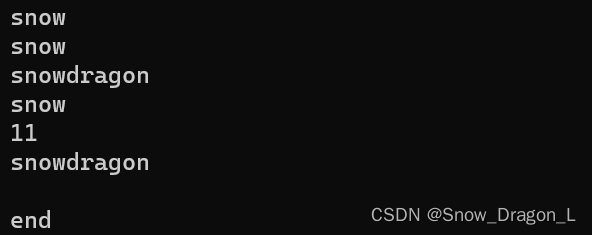
5、总结
- string对象字符串的大小是由它的实际大小size决定的,当输出时,将输出到下标为size - 1时才结束,因为下标为size处的值为\0。
- 当输出string对象时,\0默认是不输出的。
- 常量字符串对象或用string对象转换为C类型的字符串时,字符串的结束标志是\0。
十、搜寻与截取
1、类型
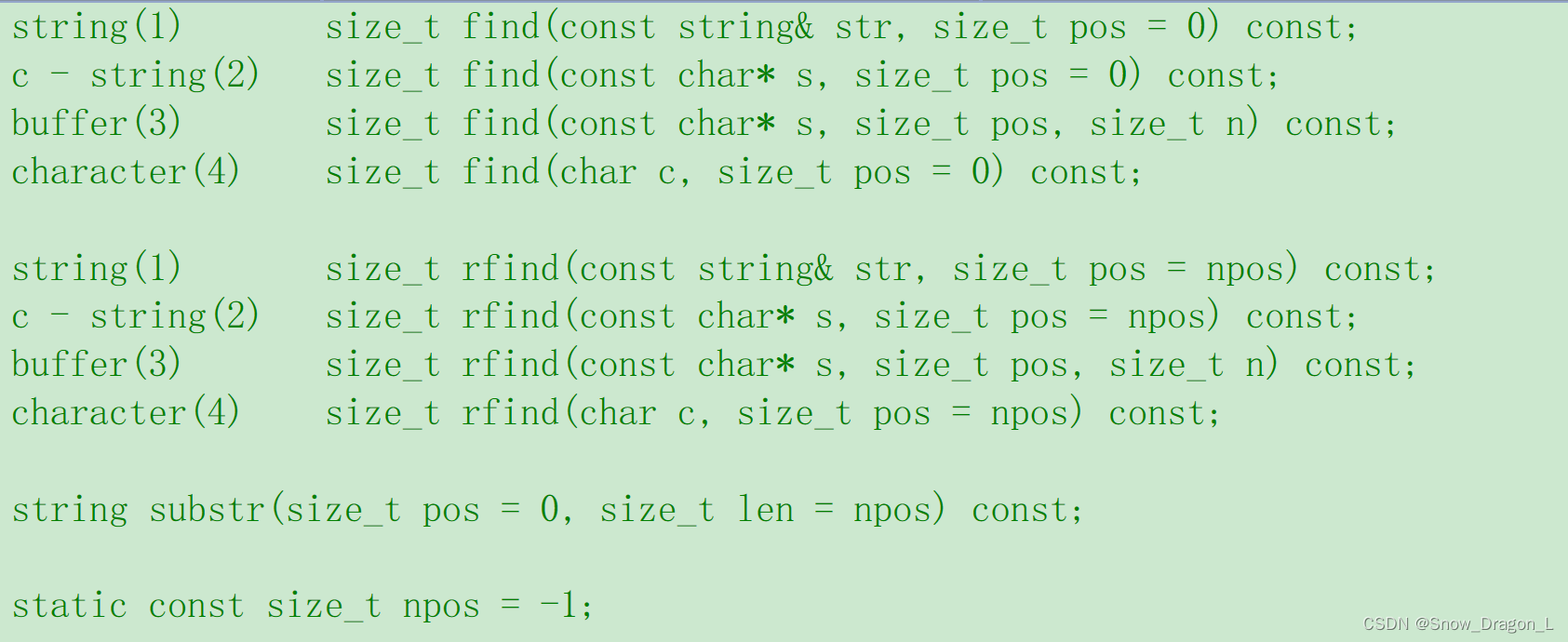
2、作用
- find是在字符串中搜索其第一个形参,如果在string对象(字符串)中找到了,则返回开始匹配处的下标;当形参pos指定时,find只搜索字符串下标位置pos处和它之后的字符,pos之前的字符不搜寻;当搜索多个字符时,即find的第一个形参是个字符串时,在string对象中搜寻的序列需要和该形参整个序列都匹配才行。
- rfind与find类似,只是它从字符串的尾部开始搜寻,pos指定时和find的搜寻顺序相反。
- substr在调用它的对象的字符串中,从pos位置开始,截取len个字符,然后用截取到的字符序列创建一个string对象并将其返回。
- npos是一个静态成员常量值,是类型size_t的最大值。当它在字符串的成员函数中用作len(或 sublen)参数的值时,表示直到字符串结束为止。当它作为返回值时,通常用于表示没有找到匹配项。
3、测试代码
void DealUrl(const string& url) { size_t pos1 = url.find("://"); if (pos1 == string::npos) { cout << "非法url" << endl; return; } string protocol = url.substr(0, pos1); cout << protocol << endl; size_t pos2 = url.find('/', pos1 + 3); if (pos2 == string::npos) { cout << "非法url" << endl; return; } string domain = url.substr(pos1 + 3, pos2 - pos1 - 3); cout << domain << endl; string uri = url.substr(pos2 + 1); cout << uri << endl; } void Test6() { string name("snow.dragon.happy.everyday"); //输出前缀 size_t pos = name.find('.'); if (pos != string::npos) { string suff = name.substr(0, pos); cout << suff << endl; } //输出后缀 pos = name.rfind('.'); if (pos != string::npos) { string suff = name.substr(pos); cout << suff << endl; } string url1 = "https://legacy.cplusplus.com/reference/string/string/find/"; cout << url1 << endl; DealUrl(url1); }- 1
- 2
- 3
- 4
- 5
- 6
- 7
- 8
- 9
- 10
- 11
- 12
- 13
- 14
- 15
- 16
- 17
- 18
- 19
- 20
- 21
- 22
- 23
- 24
- 25
- 26
- 27
- 28
- 29
- 30
- 31
- 32
- 33
- 34
- 35
- 36
- 37
- 38
- 39
- 40
- 41
- 42
- 43
- 44
- 45
- 46
- 47
- 48
- 49
4、运行结果

本文到这里就结束了,如有错误或者不清楚的地方欢迎评论或者私信
创作不易,如果觉得博主写得不错,请务必点赞、收藏加关注💕💕💕 -
相关阅读:
安全漏洞修复集
MySQL索引
南通,一座在直播电商里焕新的产业带城市
【Azure Developer】使用 Microsoft Graph API 获取 AAD User 操作示例
目录和文件管理
SpringBoot整合MyBatis从零开始
[Druid-1.2.11源码系列]-9-Druid销毁线程
【webrtc】sigslot : 继承has_slot 及相关流程和逻辑
【DW组队学习—Wonderful SQL】集合运算
springboot基于Java Web的华家医疗器械商城设计与实现毕业设计源码261620
- 原文地址:https://blog.csdn.net/Snow_Dragon_L/article/details/132695471
